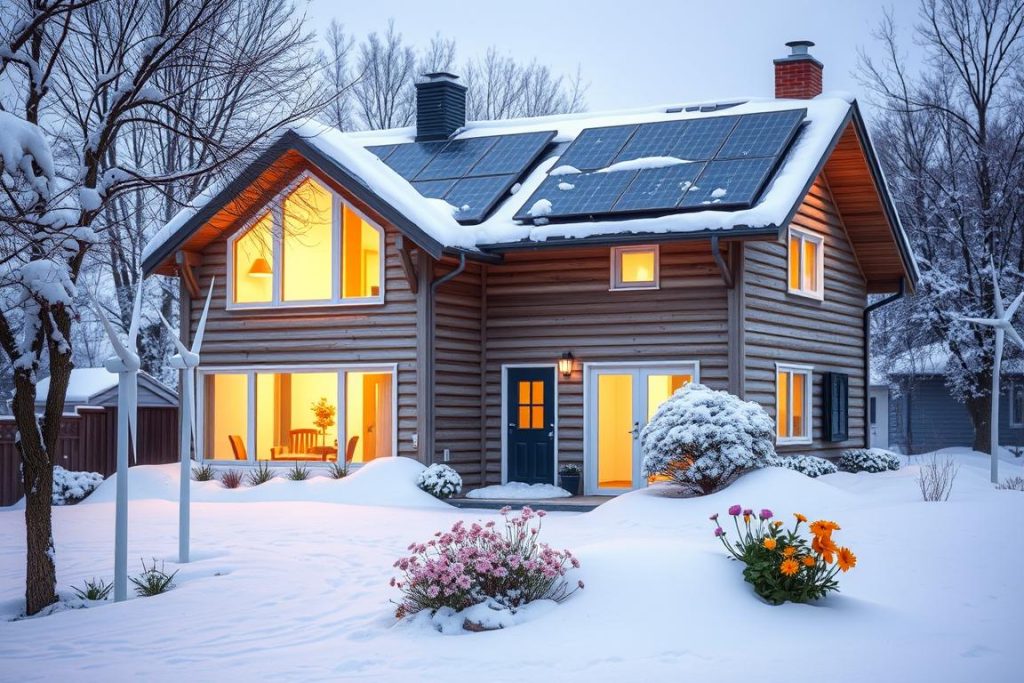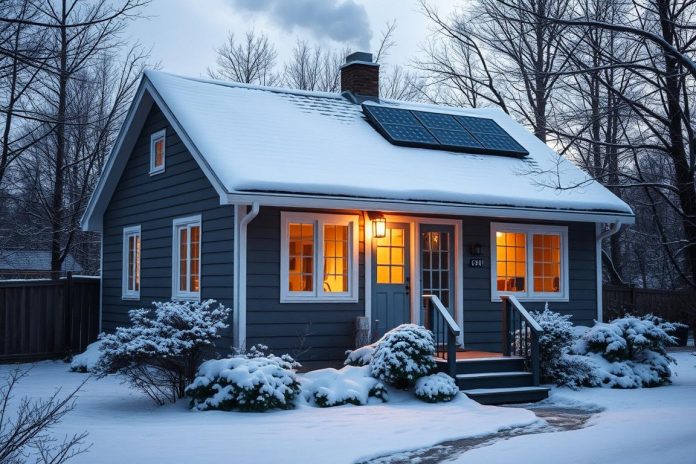About 16% of U.S. homes, or 21.2 million, can’t pay their energy bills. The Low-Income Home Energy Assistance Program (LIHEAP) helps those with low and moderate incomes handle high utility costs. Last year, it helped over 7.1 million households avoid the tough choice between heating their homes and other basic needs.
Energy costs are going up, hitting the elderly, disabled, and families with young kids the hardest. In Louisiana, 31.4% of adults in homes couldn’t pay their energy bills fully in the last year. Even though LIHEAP is crucial, its funds might drop from $6.1 billion to $4.1 billion next year. This cut could harm many families. Knowing about LIHEAP could get you the help you need for your energy bills.
Key Takeaways
- Approximately 16% of U.S. households are struggling to keep up with their energy bills1.
- LIHEAP provided financial support to 7.1 million households in FY231.
- Funding cuts could significantly impact LIHEAP, reducing its budget by $2 billion in FY241.
- In some states, over 30% of adults in households have been unable to fully pay their energy bills in the past year1.
- LIHEAP is crucial for low-income households, helping them avoid making tough choices between heating and other necessities.
Understanding LIHEAP could be a game changer for many facing tough times. It’s a way to manage your utility bills better. With financial pressures mounting, exploring LIHEAP might be the lifeline you need.
What is LIHEAP and How Does It Work?
LIHEAP stands for the Low-Income Home Energy Assistance Program. It’s a federal project that helps low-income families pay their energy bills. This program is here to lessen the burden for families who find it tough to meet energy expenses2. Knowing what LIHEAP offers is very helpful for those needing this support.
Understanding LIHEAP: Low-Income Home Energy Assistance Program
LIHEAP is run by both the federal government and local organizations. This way, it ensures the aid reaches those who really need it. In the U.S., each state, along with tribes and territories, sets its own rules on who qualifies3. Mainly, LIHEAP helps with heating and cooling payments. It may also offer help to make your home more energy-efficient and assist during energy emergencies2.
Types of Assistance Provided by LIHEAP
What kind of help does LIHEAP give? Well, there are a few types:
- Bill Payment Assistance: This is financial support to cover part of your energy bills. Amounts vary from $300 to $1,000, depending on your household4.
- Energy Crisis Assistance: This is urgent help if you’re in a serious energy pinch. Starting in December, it’s there for the elderly or those who can’t leave their homes2.
- Weatherization Assistance: This helps make your home more energy-efficient, which lowers future bills. It includes things like adding insulation or fixing your furnace3.
LIHEAP Eligibility Criteria
Want to get LIHEAP aid? Here’s what you need to know:
- You have to be a U.S. citizen or have legal immigrant status2.
- Your income can’t be over 60% of your state’s median income2.
- Help is given first-come, first-serve, with priority for the elderly or those with medical needs2.
- Some places, like Pennsylvania, have special programs for urgent heating problems4.
How to Apply for LIHEAP
Ready to apply for LIHEAP? Here’s what to do:
- Collect needed paperwork, like income proof, who lives with you, and your energy bills.
- Apply through local agencies, online, or by mail. It’s best to apply early since funds are limited3.
- After you apply, they’ll review it and tell you what help you’ll get. This might be help paying bills or making your home more efficient2.
It’s essential to apply for LIHEAP early. Funds run out, so don’t wait to get the help you need3.
Who Qualifies for LIHEAP Assistance?
To be eligible for the Low-Income Home Energy Assistance Program (LIHEAP), your household’s income and energy costs are looked at. We’ll explain the key points here.
Income Requirements for LIHEAP
Your family’s total income needs to be below certain limits to get LIHEAP help. Mainly, your earnings can’t be over 130% of the Federal Poverty Level (FPL). A family of four must make less than $34,0565 a year to qualify. Also, your savings should not be more than $2,2505. These rules make sure that help reaches those who really need it.

Households with High Energy Burden
LIHEAP looks out for families spending a lot on heating and cooling. Programs like PIPP help you pay a fixed part of your income on utilities and lower late fees6. This setup reduces the stress of high energy bills, helping families manage their money better.
Special Populations: Elderly, Disabled, and Families with Young Children
LIHEAP has special aid for the elderly, disabled, and families with little kids. In North Carolina, folks over 60 or those with disabilities getting Division of Aging and Adult Services help can apply for LIHEAP from December 1st to 31st5. This ensures that those hit hardest by energy costs get help.
Donna V. and her husband saw a big difference after joining the LIHEAP Weatherization Program at Sacred Heart Community Service. It made their house use less energy, cut down their bills, and made life better5. To learn more, go to LIHEAP Program.
Additional Benefits of LIHEAP (Low-Income Home Energy Assistance Program)
LIHEAP does more than pay for utility bills. It provides *energy efficiency* upgrades for homes. These upgrades make homes more energy-efficient. They help reduce energy use and lower bills, improving comfort and safety.

LIHEAP also funds *weatherization programs* to protect homes against harsh weather7. Grants allow up to 15% funding towards weatherization, or 25% with special permission7. This help includes adding insulation and better heating systems to save energy and money.
The program is key in offering *emergency assistance* to stop utilities from being cut off7. In tough times, especially during severe weather, it’s a lifeline for health and safety7. For FY 2023, about $1.33 billion was set for crisis help, available until mid-March.
*Community action agencies* play a big role in running LIHEAP. They ensure that help reaches those who qualify. Also, utility companies pitch in through their charities. This shows a shared goal to help low-income folks navigate tough times and changing environments8.
Conclusion
LIHEAP is very important for families with low incomes in the United States. It helps them pay for their heating and cooling needs. This support is essential. It makes sure people can be warm in winter and cool in summer. They won’t have to worry about big bills they can’t afford9.
LIHEAP really looks out for families with elderly, disabled, or young kids. These people are more affected by extreme weather. By learning if you qualify and applying, you can save on energy. You also help build a strong community that supports each other9. The difference in energy bills between low-income and better-off households is big. Being a part of LIHEAP can make a big difference in your financial health10.
When you use LIHEAP, you take a step towards better managing your energy costs. It brings together government and local groups to help reduce your energy bills. This means you can focus on other important family matters. Your life gets better, no matter your income or the time of year. Start with LIHEAP today for a more secure and comfy home10.
FAQ
What is the Low-Income Home Energy Assistance Program (LIHEAP)?
Who is eligible for LIHEAP?
How do I apply for LIHEAP?
What types of assistance does LIHEAP provide?
Are there any specific benefits for certain populations?
Can I receive emergency assistance through LIHEAP?
What is the income requirement for LIHEAP?
How does LIHEAP support households with high energy burdens?
Are there any long-term benefits to applying for LIHEAP?
What role do community action agencies play in LIHEAP?
Source Links
- Need Help Paying Utility Bills? See if You Qualify for LIHEAP – https://www.ncoa.org/article/what-is-the-low-income-home-energy-assistance-program-liheap/
- Low Income Home Energy Assistance Program (LIHEAP) – https://dfcs.georgia.gov/services/low-income-home-energy-assistance-program-liheap
- LIHEAP FAQs for Consumers – https://www.acf.hhs.gov/ocs/faq/liheap-faqs-consumers
- Apply for the Low Income Home Energy Assistance Program (LIHEAP) – https://www.pa.gov/en/services/dhs/apply-for-the-low-income-home-energy-assistance-program-liheap.html
- Low-Income Home Energy Assistance Program (LIHEAP) – Action NC – https://actionnc.org/tenant-organizing-resource-center/utility-resources/low-income-home-energy-assistance-program-liheap/
- Low Income Home Energy Assistance Program | Citizens Utility Board – https://www.citizensutilityboard.org/learn-about-liheap/
- LIHEAP Fact Sheet – https://www.acf.hhs.gov/ocs/fact-sheet/liheap-fact-sheet
- New Jersey Department of Community Affairs (DCA) – https://www.nj.gov/dca/dhcr/offices/hea.shtml
- What is LIHEAP and CEAP Energy Assistance? – Now Power – https://nowpowertexas.com/what-is-liheap-and-ceap-energy-assistance/
- Fy 2000 LIHEAP Home Energy Notebook – https://www.energy.gov/scep/slsc/articles/liheap-energy-burden-evaluation-study

